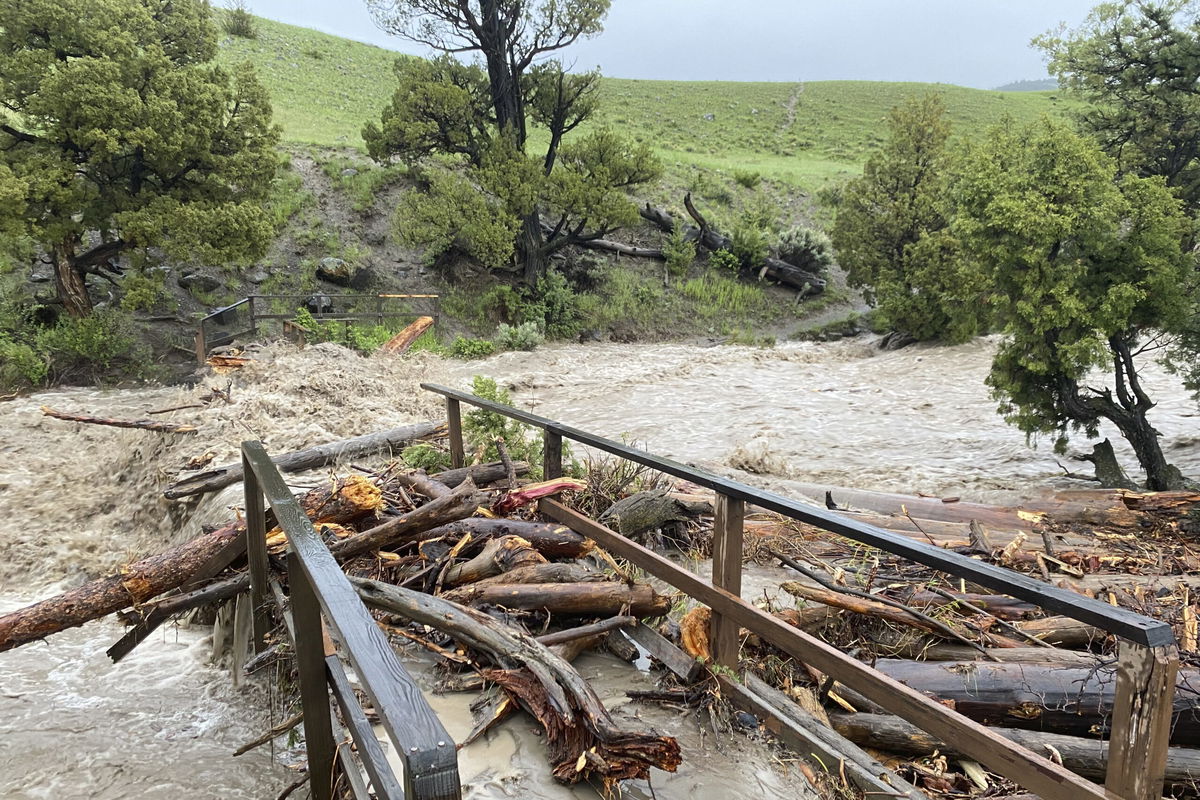Across the US, a day of extreme weather prompts heat warnings, severe flooding and power outages for hundreds of thousands

In a matter of hours on June 13
By Elizabeth Wolfe, CNN
In a matter of hours Monday, the iconic landmarks of Yellowstone National Park were shuttered to the public and its roads left unpassable after a torrential downpour and rapid snowmelt contributed to unprecedented flooding at one of America’s most visited national parks.
A helicopter flying overhead captured scenes of destruction — with massive chunks of concrete snatched from the road as the swollen Gardner River raged outside its banks. It was one of many scenes of extreme weather Monday across the US.
In a span of 24 hours, American communities grappled with a slew of severe weather threats that left hundreds of thousands without power in the Midwest, trapped flooded communities in Montana without clean drinking water, prompted tornado warnings in Chicago and left millions battling sweltering heat.
These are the extreme weather events the US endured Monday.
Hundreds of thousands without power in the Midwest
Severe storms that moved across the Upper Midwest and the Ohio River Valley left more than 620,000 customers without power early Tuesday, according to PowerOutage.us, with more than 370,000 outages in Ohio alone.
Thunderstorms prompted a tornado warning in Chicago during the busy evening rush hour as wind gusts of up to 84 mph buffeted the city.
The same storm system brought lashing winds and rain to portions of western Ohio, Michigan and northern Indiana, generating more than 200 wind reports in the region, including a 98 mph gust in Fort Wayne, Indiana.
Millions endure dangerous heat
A heat dome that enveloped the Southwest in heat and humidity last week shifted to the central US and put more than 125 million people in the region under heat advisories.
That’s more than one third of the US population enduring potentially dangerous heat levels.
Several cities set temperature records Monday afternoon, including Asheville, North Carolina, St. Louis and Nashville. In North Platte, Nebraska, the temperature rocketed to a record 108 degrees.
The heat will continue to travel northeast into the upper Mississippi Valley, western Great Lakes and Ohio Valley, and it will continue to build Tuesday over the southern Mid-Atlantic and Southeast, according to the Weather Prediction Center.
More than 100 million people are under some sort of heat alert Tuesday.
Excessive heat forecasts forced some schools in Michigan, Minnesota and Wisconsin to announce that classes will be canceled, close early or move online this week.
Even after this heat dome subsides, relief could be short-lived. Heat waves will become increasingly common and more severe, experts say.
“Climate change is increasing the frequency and intensity of heat waves around the world, tilting the scale in the direction of warmer temperatures,” CNN meteorologist and climate expert Brandon Miller explained.
“In the United States, record high temperatures are now well more than twice as likely to occur compared to record low temperatures,” according to the US National Climate Assessment.
Extreme flooding shuts Yellowstone, strands locals
Heavy rainfall and rapid snowmelt drove extreme flooding and road erosion in Yellowstone National Park and some surrounding communities, forcing officials to close the park to incoming visitors and leaving many nearby residents unable to escape the rising water due to compromised roads.
Communities north of the park are experiencing dramatic flooding, including in Park County, Montana, where cities have become isolated and surrounded by water, an update on the county Facebook page said.
In nearby Carbon County, Montana, utility services lines were compromised by the flooding, leaving many customers in the town of Red Lodge without power and leading officials to issue a water boil advisory, officials said.
Rushing water has left homes damaged or fully swept away, images and videos show. One video shows a multi-story home collapsing into the rushing water and being entirely enveloped by the deluge as the underlying foundation crumbles.
Portions of roads and bridges in Yellowstone National Park were also compromised by flooding, officials said. Videos released by the park show large sections of paved roads completely washed away or drastically eroded.
The park began evacuating people Monday due to road and bridge failures, as well as concerns over forecasts of more rain and potential water and wastewater problems.
Precipitation levels more than 400% above average in the region, combined with near-record temperatures causing snowmelt in areas of high elevation, have inundated rivers and streams to record levels.
The Yellowstone River gauge at Corwin Springs, Montana, reached 13.88 feet Monday afternoon, surpassing the historical high crest of 11.5 feet from 1918, NOAA river gauge data shows.
The-CNN-Wire
™ & © 2022 Cable News Network, Inc., a WarnerMedia Company. All rights reserved.
CNN’s Brandon Miller, Haley Brink, Joe Sutton, Raja Razek, Sara Smart, Amanda Jackson and Claudia Dominguez contributed to this report.
